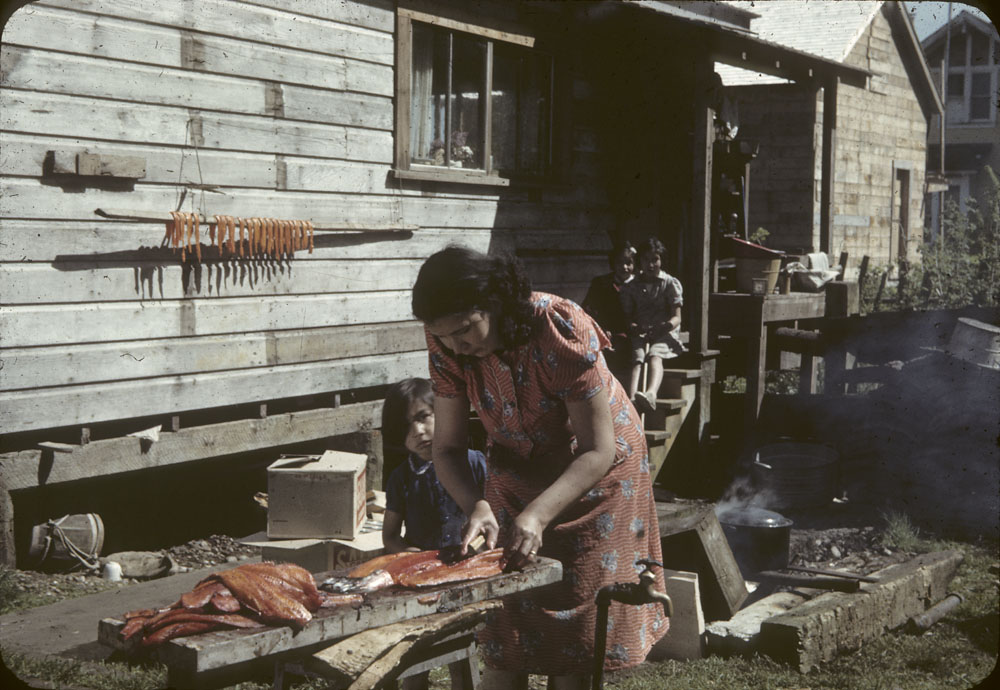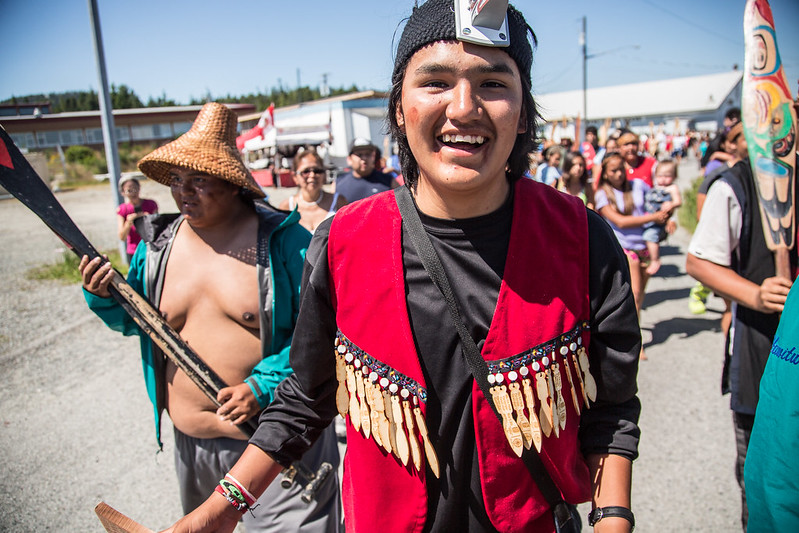As of 2019, there were 1,583 reserves in British Columbia associated with 203 Indigenous Nations (see also First Nations in British Columbia). Unlike many other parts the country, where reserves resulted from treaties made between the federal government and Indigenous Nations, most reserves in BC were created without such negotiations. Only two general locations in BC are covered by historic treaties: parts of Vancouver Island are covered by the Douglas Treaties, and the northeast corner of the province by Treaty 8. In BC as with other parts of the country, reserves are bound by the terms of the Indian Act. However, given the number of Indigenous Nations without a treaty in BC, the province has implemented a modern treaty negotiation process. Several BC Indigenous communities have used this process or other means to negotiate self-governing agreements. These agreements place decision-making authority over land management in the hands of Indigenous governments.
Douglas Treaties
In 1849, Vancouver Island became a British colony. (At the time, the Hudson’s Bay Company asserted jurisdiction on the mainland of what would become British Columbia.) Between 1850 and 1854, the colony’s second governor, James Douglas, a high-ranking fur trader, negotiated 14 treaties with several Indigenous Nations. These treaties, which cover land in and around Victoria, Saanich, Sooke, Nanaimo and Port Hardy, included the identification of protected reserve lands. Settler immigration to Vancouver Island remained slow throughout the 1850s.
Anticipatory Indian Reserves
In 1858, more than 30,000 gold miners, mostly American, suddenly arrived in mainland British Columbia. They came to join the Fraser River Gold Rush. As a consequence, in addition to the existing colony of Vancouver Island, Britain established the colony of British Columbia. James Douglas became the governor of both. The arrival of the gold miners highlighted the need for a policy to regulate Indigenous-settler relations. London would not provide money for formal treaty negotiations, but Douglas nonetheless conceived of a policy. He did so in consultation with Indigenous people and in reaction to American Indian policy south of the border.
In a letter to London officials in March 1859, Douglas explained that his vision was to ensure the self-sufficiency of Indigenous people by creating “Anticipatory Reserves.” These reserves would not only “include their cultivated fields and village sites,” but also additional lands that could be used for commercial farming and ranching. Such lands would literally anticipate the future needs of Indigenous people, and could be temporarily leased to settlers. All proceeds from leasing the land would go back to the Indigenous community.
Some Indigenous leaders feared that the BC government might follow the American practice of removing Indigenous people from their ancestral settlements and lands. In response to these fears, Douglas explained that he had instructed government officers “to stake out, and reserve for their use and benefit, all their occupied village sites and cultivated fields, and as much land in the vicinity of such as they could fill, or was required for their support.”
Central to Douglas’ Indian policies was the additional commitment to facilitating Indigenous people’s participation in the emerging settler society. While lands outside of reserves would be available for settlers to develop as towns and farms, Douglas explained that Indigenous people “might freely exercise and enjoy the rights of fishing the Lakes and Rivers, and of hunting over all unoccupied Crown Lands in the Colony.” Overall, Douglas reported that he “strove to make them [Indigenous people] conscious that they were recognized members of the Commonwealth.” Under his administration, Indigenous people were entitled to purchase mining licenses and to register pre-emptions for private farm and ranch lands. Some Indigenous leaders were even appointed to positions as magistrates during Douglas’ tenure.

Indigenous oral histories reflect their shared understanding of a future where Indigenous people and settlers respected one another. In 1915, Chief John Leon of the Sts'ailes Nation remembered Douglas’ policies in this way:
"Sir James Douglas, the first Governor made a verbally promise to us Indians on his first surveying the land. He said, for which I survey as Indian lands it really belong to the Indians only. That no white man shall intrude in your lands and for all that outside of your lands Her Majesty Queen Victoria will take and sell to the white people and that land will be likeness to a lasting fruit tree for the Indians. Her Majesty will take the said fruits and give it to the Indians as their lasting support."
Douglas’ vision, however, was not widely shared by senior officials in his administration or the general settler public. In particular, Colonel R.C. Moody, Chief Commissioner of Land and Works, repeatedly inserted caveats into Douglas’ instructions. His interference curtailed Indigenous agency and opened more lands to speculators and settlers. Douglas regularly had to clarify to Indigenous people and government officials alike that it was Indigenous Nations themselves who had the right to identify the lands that would become reserves.
Between 1861 and his retirement in the spring of 1864, Douglas met directly with Indigenous leaders and provided verbal and written instructions to surveyors. These instructions resulted in the demarcation of relatively large Anticipatory Reserves throughout much of the colony. In the BC interior, for example, Commissioner William Cox and Chief Louis Clexlixqen identified a reserve that stretched eastward from Kamloops along the Thompson River for over 19 km, up the North Thompson River for over 9 km, and then back to the mountains. Similarly, along the lower Fraser Valley a total of 39,900 acres (161.5 km2) were set aside for the Stó:lō living in the Abbotsford and Chilliwack region.
Disavowal of Douglas Reserves
Following James Douglas’ retirement, Joseph Trutch replaced R.C. Moody as Chief Commissioner. In this role he assumed de facto control over the mainland colony’s Indian policy. Trutch was a racist who believed Indigenous people were inherently inferior to Europeans. He said his policy would be “to disavow absolutely” the legitimacy of the reserves that had been identified through Douglas’ directives.
Under Trutch, Indian reserves were dramatically reduced in size. In 1867, for example, a 9,600 acre (38.85 km2) Matsqui reserve in present day Abbotsford was reduced to a mere 80 acres (0.33 km2). The giant Kamloops reserve, likewise, became a mere “three square miles” (7.77 km2).
BC Joins Confederation
British Columbia joined Confederation in 1871 and Joseph Trutch was appointed the province’s first Lieutenant Governor. As one of the key architects of the terms of BC’s union with Canada, Trutch inserted a clause that hamstrung efforts by future federal officials to establish relatively large reserves in BC. Elsewhere in Canada, such reserves were being created through the numbered treaty process.
Under these constraints, Reserve Commissioner Gilbert M. Sproat could only partially respond to Indigenous demands for the return of their original reserve lands. During his tenure, communities like Matsqui had their then 80 acre reserve expanded into four separate reserves comprising 608 acres in total (2.46 km2). However, many other Indigenous Nations’ requests went unanswered.
Sproat resigned in frustration in 1880. Trutch (who had been appointed dominion agent for BC by Prime Minister John A. Macdonald) was then successful in having his brother-in-law Peter O’Reilly made Reserve Commissioner. This ensured that subsequent reserve creation did not deviate far from Trutch’s earlier vision of marginal spaces for marginalized people.
The exception was in the extreme northeast section of the province. There, in 1899, the federal government responded to Indigenous requests for a treaty (and therefore also reserves) as part of the Treaty 8 negotiations taking place on the Canadian prairies. The BC government, which had consistently opposed calls for treaties within its jurisdiction, was informed of the treaty negotiations. However, as historian Arthur Ray explains, the province chose to remain uninvolved, neither consenting nor objecting to the process.

The McKenna-McBride Commission
Across the province, Indigenous people continued to press for more and larger reserves, as well as for compensation for alienated lands. In an effort to bring an end to what was commonly referred to as “the land question,” the federal and provincial governments established the Royal Commission on Indian Affairs for the Province of British Columbia (also known as the McKenna-McBride Commission). Between 1913 and 1916, the Commission traveled the province gathering evidence from Indigenous and settler witnesses. In the end, it added land to many existing Indian reserves. However, to Indigenous peoples’ disappointment it also reduced the land base of reserves the commissioners felt were not being adequately used. Some existing reserves were eliminated altogether.
British Columbia Treaty Negotiation Process
The McKenna-McBride Commission did not put an end to the Indian land question. Rather, it cemented Indigenous resolve and determination. Over the following decades Indigenous people re-doubled their efforts to secure recognition of their title, compensation for alienated lands, and larger reserves. In 1992, after Indigenous Nations such as Musqueam had successfully argued their land and fishing rights in court, the provincial government finally consented to joining in a formal treaty making framework. Since then, the BC treaty negotiation process has resulted in five finalized treaties, three of which are in effect: the Tla'amin, Maa-nulth, and Tsawwassen treaties. Each treaty that results from the process is a self-government agreement. These agreements, among other things, have redefined the meaning of former reserve lands. However, not all BC Indigenous Nations have opted into the treaty process, and some have left in frustration. Still other communities have secured self-governance agreements outside of the BC treaty negotiation process, namely the Shíshálh Nation (formerly known as Sechelt First Nation), Nisga'a Nation, and Westbank First Nation. These agreements are reforming Indigenous peoples’ relationships to the federal and provincial governments in BC.

Resurgence and Reconciliation
Indigenous people continue to struggle under settler colonialism. However, many First Nations are successfully transforming reserve lands into dynamic self-governing communities with vibrant economic, social, educational, and artistic activities. Through activism, court challenges, public education initiatives, and negotiations, leaders are re-establishing an increasingly meaningful say in the governance of their broader ancestral lands and resources. The ongoing Indigenous political and cultural resurgence is not only transforming Indigenous communities, but also the relationship between Indigenous people and settlers, and Canadian society and federalism. Many see this as a meaningful step towards genuine reconciliation.

 Share on Facebook
Share on Facebook Share on X
Share on X Share by Email
Share by Email Share on Google Classroom
Share on Google Classroom



